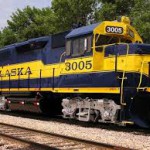 The Alaska Railroad Corp. is requesting that Gov. Sean Parnell include $40 million in his fiscal year 2015 budget submission for safety improvements to passenger service. The railroad is making the request to comply with federally mandated passenger safety upgrades. According to the railroad’s budget request, more than $150 million total will be required to complete the federal mandate by 2018.
The Alaska Railroad Corp. is requesting that Gov. Sean Parnell include $40 million in his fiscal year 2015 budget submission for safety improvements to passenger service. The railroad is making the request to comply with federally mandated passenger safety upgrades. According to the railroad’s budget request, more than $150 million total will be required to complete the federal mandate by 2018.
The federal mandate “is too big a lift for our current financial situation to support,” railroad spokesman Tim Sullivan said.
Parnell will present his budget later this year.
The mandates were established by Congress in 2008 in response to train accidents. They are supposed to make rail service safer.
The railroad has already spent $63.8 million on the program, it says. That number includes $19.1 it received from the legislature last year, an appropriation that was requested by Parnell in the final hours of the legislative session without time for committee review or public comment. All told, the railroad will need an additional $69.7 million from 2015 to 2018 to complete the project.
The $40 million is for both fiscal year 2015 and 2016.
“At stake is the continuation of Alaska Railroad passenger service,” Sullivan said.
Roughly 400,000 people a year ride the railroad. About 60 percent of those passengers come to Alaska via cruise ships. It’s unclear how many Alaskans take the train. The direct financial impact to Alaska if the passenger service is disrupted is also unclear. The railroad is working on an impact study, Sullivan said.
A disruption would undoubtedly impact businesses and communities that rely on tourism.
The railroad and all its assets were transferred from federal to state hands in 1985 and was established as a state-owned corporation. Those assets now total about $989 million and include about 500 miles of railroad line and about 36,000 acres of land, about half of which are available for lease, and which accounted for roughly $10 million of the railroad’s revenue in 2012.
It does not pay state or corporate income taxes, nor any property taxes.
Its total revenue in 2012 was $190.4 million, including about $40 million of federal government grants.
According to the railroad’s annual report, operating revenues exceeded operating expenses by $3.8 million.
Unlike the Alaska Housing Finance Corp., another state corporation, the Legislature has no say over the railroad’s budget, and it doesn’t pay annual dividends to the state. The intent was for the corporation to use any profits to be self-sustaining. However since 1996, it has relied on federal grants to make ends meet, and state appropriations in the last few years for capital projects.
In the past, there have been discussions about giving the Legislature more control over the railroad’s budget through the Executive Budget Act, which the railroad has always strenuously opposed on grounds that they weren’t asking for or needed state appropriations.
Contact Amanda Coyne amandamcoyne@yahoo.com

